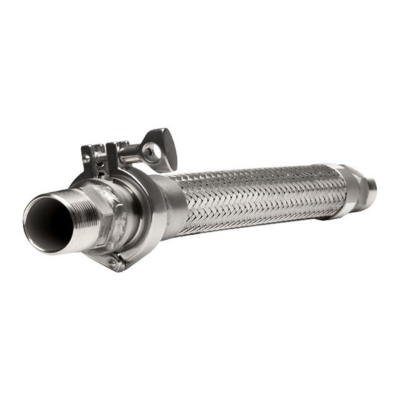Dispenser Safety Equipment: Flex Connectors
Written by: Brian Pottebaum, Director of Training Services
Dispensers are found at retail fueling facilities and convenient stores. They are used to refuel vehicles, engine-powered equipment, storage containers, and more. Dispensers can pump hundreds of gallons of fuel daily, so they must have safety equipment, constant maintenance, and routine inspections.
Not only is it necessary, but it is also required by industry standards and national fire protection code to provide flexibility when connecting the fuel supply line at the tank end and under the dispensers. Flex connectors are UL listed and designed to meet the requirement. Flex connectors can be installed aboveground as well as underground, but they need to be listed and fire rated for the intended application.

What is a flex connector?
Flex connector is defined by the Petroleum Equipment Institute as a short, braided metal hose assembly used to connect piping to a fuel dispenser, submersible pump, or the vent opening in an underground tank. A typical flex connector is about 2 feet in length and has an outer covering of braided stainless-steel mesh. (PEI RP900, Section 2.27, Page 6)
Why are they installed?
Flex connectors provide piping systems with the flexibility needed to absorb hydraulic shock and vibration, compensate for thermal growth and ground movement, and permit the motion of other piping elements. Flex connectors can also help correct minor piping alignment discrepancies.
Flex connectors must be installed carefully and correctly. They cannot be twisted or bent beyond the manufacturer specified bend radius. Correct tools and wrenches must be used when installing the fitting. Flex connectors carrying product should never be permanently buried or submerged in water because they are metallic construction and will corrode if not properly protected. Access to them is also necessary for inspection and routine maintenance. When installed on tank vent lines, the flex connectors are typically coated and/or wrapped prior to burial to protect the fittings from corrosion.
How to maintain and inspect
Although the enforcement and regulatory requirements can vary in different areas, routine maintenance and inspections are always advised to make sure the flex connectors are in good condition. Proper maintenance should include cleaning around the fitting anytime there is contact with liquid or soil/backfill material. Contact with these elements can cause corrosion, therefore periodic cleaning is necessary.
Flex connectors must also be closely inspected periodically. This should be included as part of the annual walkthrough inspections. These fittings should be thoroughly inspected for leaks, damage, and corrosion. The fitting should not have any bulging or excessive wear. Additionally, make sure the fittings are not resting on or rubbing against other components in the sump area. Occasionally, these areas get congested with electrical conduit and junction boxes, vent lines, and additional product piping. Flex connectors cannot be allowed to be in contact with other metallic structures because that can cause corrosion and damage to that area.
Flex connectors are a durable component in the piping system; however, they need proper care to endure the conditions and constant workload. They are put to the test every time the system turns on and off. Make sure to monitor your flex connectors closely.


